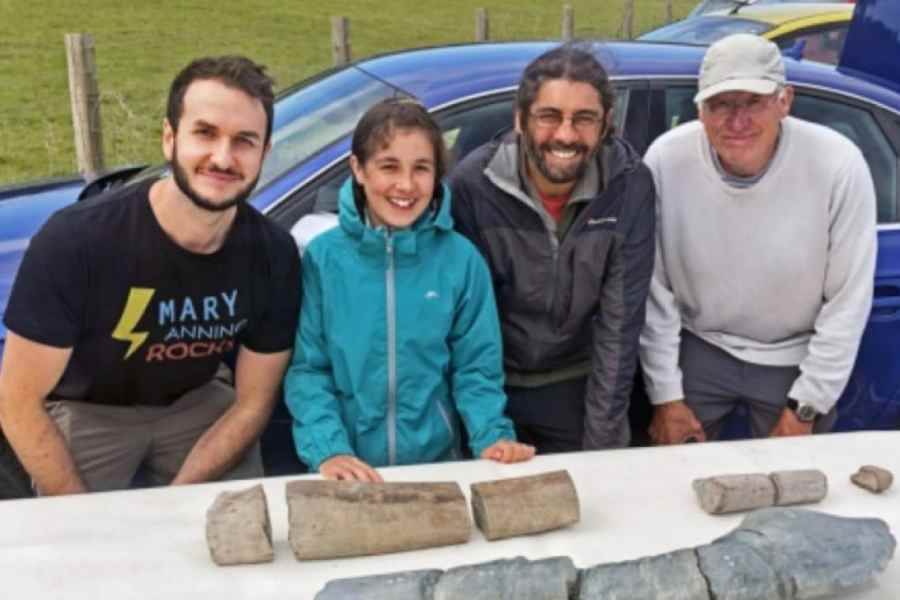In 1811, a 12-year-old girl named Mary Anning discovered a fossil on the beach near her home in southwestern England — the first scientifically identified specimen of an ichthyosaur, a dolphin-like, ocean-dwelling reptile from the time of the dinosaurs.
Two centuries later, less than 80km away, an 11-year-old girl named Ruby Reynolds found a fossil from another ichthyosaur. It appears to be the largest marine reptile known to science.
Ruby Reynolds, now 15, and her father, Justin Reynolds, have been fossil hunting for 12 years near their home in Braunton, England. On a family outing in May 2020 to the village of Blue Anchor along the estuary of the River Severn, they came across a piece of fossilised bone set on a rock.
“We were both excited as we had never found a piece of fossilised bone as big as this before,” Justin Reynolds said. His daughter kept searching the beach, he added, “and it wasn’t long before she found another much larger piece of bone.”
They took home the fragments of bone, the largest of which was about eight inches long, and began their research. A 2018 paper provided a hint at what they’d found: In nearby Lilstock, fossil hunters had discovered similar bone fragments, hypothesised to be part of the jaw bone of a massive ichthyosaur that lived roughly 202 million years ago.
However, the scientists who’d worked on the Lilstock fossil had deemed that specimen too incomplete to designate a new species.
Justin Reynolds contacted those researchers: Dean Lomax, at the University of Bristol, and Paul de la Salle, an amateur fossil collector. They joined the Reynolds family on collecting trips in Blue Anchor, digging in the mud with shovels. Ultimately, they found roughly half of a bone that they estimate would have been more than seven feet long when complete.
Several features of the bone’s shape indicate that it came from an ichthyosaur’s jaw. To further confirm its identity, the researchers collaborated with Marcello Perillo, a palaeontologist with the University of Bonn in Germany. Under a microscope, he found crisscrossed collagen fibres, an ichthyosaur trait. He also saw that despite the giant size of the jaw bone, the reptile hadn’t finished growing when it died.
Taken together, the fossils from Blue Anchor and Lilstock offered evidence of something special.
“Having two examples of the same bone that preserved all the same unique features, from the same geologic time zone, supported the identification that we’ve kind of toyed around with before, that it’s got to be something new,” Dr Lomax said.
“That’s when it got really exciting.”
He and his co-authors of a paper describing the fossil in the journal PLOS One on Wednesday named it Ichthyotitan severnensis, the giant fish lizard of the Severn.
Their estimates suggest that Ichthyotitan could have been up to 82 feet long, rivalling the size of a blue whale and making it the largest marine reptile known to science. It lived right before a massive extinction that ended the Triassic Period.
“Inevitably with big extinction events of course, it’s the big things that go first, and so in this case, literally the biggest things in the ocean, they are wiped out, and this entire family disappears,” Lomax said.
Erin Maxwell, a palaeontologist at the State Museum of Natural History, Stuttgart, Germany, who was not involved with the study, said that the find had shed light on ichthyosaur evolution. “Before, there were hints that there were these giant ichthyosaurs approaching the Triassic-Jurassic boundary, but the amount of evidence is becoming incontrovertible at this point,” she said.
Dr Lomax said this discovery had also highlighted the importance of amateur fossil collectors. “If you have a keen eye, if you have a passion for something like that, you can make discoveries like this,” he said.
Ruby Reynolds said: “I didn’t realise when I first found the piece of ichthyosaur bone how important it was and what it would lead to. I think the role that young people can play in science is to enjoy the journey of exploring as you never know where a discovery may take you.”
New York Times News Service










